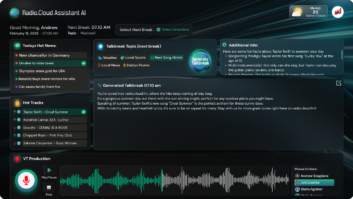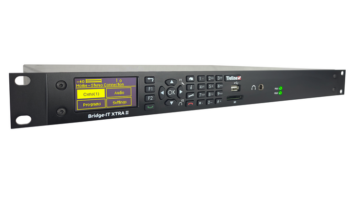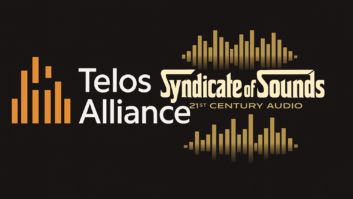As the NAB Show gets closer, we continue our series of short Q&As with manufacturers about their plans and offerings, to help you get the most out of the big annual trade show. John Lackness is vice president of sales, Americas, for Tieline.
Radio World: How has business been for the company since last year’s NAB Show?
John Lackness: The year since the 2014 NAB show has probably been one of Tieline’s best years ever. With new enhancements to existing products and great customer input and feedback concerning these enhancements, this has increased sales. However more importantly, new solutions have given our customers additional products that have helped them answer their remote, audio STL and distribution needs.
RW: What do you anticipate will be the most significant technology trend at the 2015 NAB Show?
Lackness: The inexorable shift towards IP distribution in all sectors of broadcast will continue unabated. On a daily basis U.S. networks ask us for solutions which allow them to transition out ISDN codecs and into IP codecs. Engineers are also realizing they can save big money on network costs by transitioning out of shrinking ISDN networks and expensive satellite links into affordable IP connections.
Flexible codec solutions allow engineers to continue supporting ISDN and transition into IP as required over time. Tieline and other codec manufacturers will be speaking on this very topic at the Public Radio Engineering Conference before the NAB show on Friday, April 10th.
In addition, there’s no doubt the importance of AES67 is on everyone’s lips and what this means for IP interoperability. Tieline Merlin Plus and Genie Distribution audio codecs with WheatNet-IP are already fully AES67 compatible via the WheatNet audio card in these codecs.
RW: The IP revolution has greatly affected the codec world, what’s the latest trend in codecs?
Lackness: The trend globally is for codecs to support multiple audio streams and flexible audio distribution solutions. From a remote perspective, the ability to connect multiple remote devices to a studio unit and manage them independently is important. From an audio distribution perspective, flexible solutions incorporating multiple peer-to-peer connections, multicasting and multi-unicasting, allow engineers to use a single box to create multiple STL-grade IP streams.
Regionally, there are some differences in IP streaming preferences. For example, in Europe broadcasters are more heavily into using SIP to connect over IP than other protocols. This led Tieline to recently release firmware supporting up to six simultaneous SIP connections in codecs like Genie Distribution and Merlin Plus.
RW: What new goodies will your company be showing? Why should attendees visit your booth?
Lackness: For the thousands of Bridge-IT and Bridge-IT XTRA codec owners out there we can announce the imminent release of a major firmware upgrade, which includes a multitude of enhancements. These include a range of new operational features, plus algorithms such as Opus, AAC-LD and AAC-ELD. This update also includes a significantly enhanced web GUI interface which will improve remote codec configuration and control.
A lot of people are surprised when they learn about the flexibility of multi-stream codecs like Genie Distribution and Merlin Plus. Tieline recently released a new POTS module for the Genie and Merlin families of codecs. This means broadcasters can now use these codecs to connect over IP, ISDN or POTS networks as required.
Also, up to six simultaneous audio streams can be configured with different algorithms and bit rates, which is a little-known but really cool feature. Over IP you can also dial using Tieline’s proprietary session data and configure your remote codec automatically, or use SIP for interoperability, plus we support sessionless IP connections and EBU-standard I3P intercom interoperability.
RW: The Internet has changed the way people do business. Some would say that it has rendered shows such as the NAB obsolete. Is this true?
Lackness: For manufacturers and customers nothing beats face-to-face communication. For manufacturers it means getting honest feedback about what’s good and what can be improved in a product category. For customers it provides an opportunity to actually see hardware in action and fully understand equipment features.
RW: You’re a show veteran, what’s your favorite thing about the show? Least favorite thing?
Lackness: I think I am a newbie compared to many of the NAB attendees. This will be #24 for me. Like a lot of attendees, it is fun to see new products that companies are introducing during the year, and also to catch up with friends who you have known for years or have only talked to on the phone. The least favorite is the endless standing. I hate my feet at the end of the day. I THOUGHT I had found the perfect pair of convention shoes last year, only to be SORELY disappointed.
RW: Do you have any suggestion that would make the show a better experience for exhibitors and/or attendees?
Lackness: Like my statement above, do some research on good convention shoes and break them in properly, you will thank yourself at the end of the day. If attendees would like more one on one time with us, they should really look at coming by our booth Wednesday afternoon and during the day Thursday, when the crowds have thinned somewhat and more quality time can be given to you. The crush and madness that is the first day of the show can be somewhat overwhelming for first time exhibitors and attendees.







